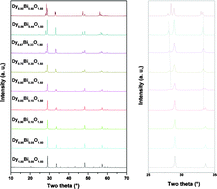Phase evolution and oxide ion conduction behavior of Dy1−xBixO1.5 (0.00 ≤ x ≤ 0.50) composite system†
Abstract
A series of Dy1−xBixO1.5 (0.00 ≤ x ≤ 0.50) compositions were prepared by conventional solid state reactions of Bi2O3 and Dy2O3.

* Corresponding authors
a
Chemistry Division, Bhabha Atomic Research Centre, Mumbai 400085, India
E-mail:
sachary@barc.gov.in, aktyagi@barc.gov.in
Fax: 0091-22-25505151
Tel: 0092-22-25592328
b Glass & Advanced Ceramics Division, Bhabha Atomic Research Centre, Mumbai 400085, India
A series of Dy1−xBixO1.5 (0.00 ≤ x ≤ 0.50) compositions were prepared by conventional solid state reactions of Bi2O3 and Dy2O3.

 Please wait while we load your content...
Something went wrong. Try again?
Please wait while we load your content...
Something went wrong. Try again?
Vasundhara, S. J. Patwe, A. K. Sahu, S. N. Achary and A. K. Tyagi, RSC Adv., 2013, 3, 236 DOI: 10.1039/C2RA21352D
To request permission to reproduce material from this article, please go to the Copyright Clearance Center request page.
If you are an author contributing to an RSC publication, you do not need to request permission provided correct acknowledgement is given.
If you are the author of this article, you do not need to request permission to reproduce figures and diagrams provided correct acknowledgement is given. If you want to reproduce the whole article in a third-party publication (excluding your thesis/dissertation for which permission is not required) please go to the Copyright Clearance Center request page.
Read more about how to correctly acknowledge RSC content.
 Fetching data from CrossRef.
Fetching data from CrossRef.
This may take some time to load.
Loading related content
